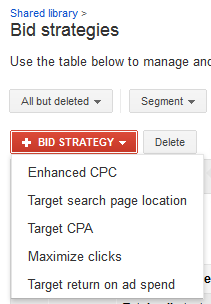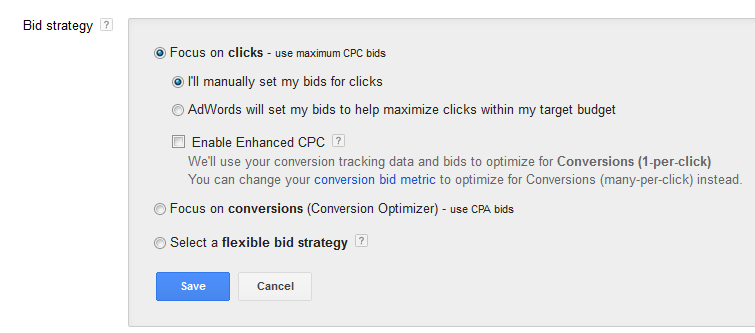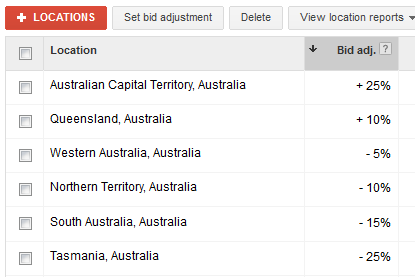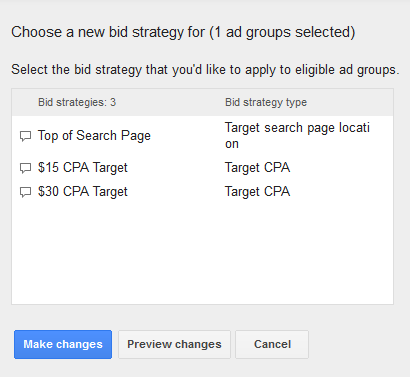For this month’s series, we’re providing a little bit of perspective on the hectic events of 2013. As we’ve left Enhanced Campaigns pretty well covered this year, this week we’ll be dedicating our time to some of the other (non-Enhanced Campaigns) initiatives, tactics, strategies, and features that we used to excel in 2013 here at PPC Hero.
———-
When you boil paid search down to its basic elements, there are three things that rise above all else: Bids, Ads and Keywords (BAKs for those who love acronyms). While ads have continued to evolve this year with new extensions and formats, bids have been the portion of this holy trinity of PPC that have changed the most over the past 12 months. Today we’re going to recap exactly how things are different now to a year ago and how you should approach your bid strategy.
The basics
Setting a bid in PPC is on the face of it a fairly simple thing to do. Here’s the formula I use to set my bids:
Max CPC Bid = Conversion Rate * Target Cost per Conversion
The simplest way to do this is by pulling your historical conversion rate data by keyword into a tool like Excel, adding a column for “Target Cost per Conversion” – something which is a factor of how much profit you generate from each lead or sale you convert – and multiplying them together for a desired CPC you wish to pay.
Which bid strategy should you be using?
Regular CPC Bidding
- As listed in the above section, this gives you control over your CPCs on each of your specific keywords.
- Typically requires time to go through every week to make sure that bids are optimized with fluctuating conversion rates.
Auto-Bidding:
- Auto-bidding will bring you the most number of clicks Google can get from your campaign daily budgets. This works by making bid adjustments for you that bring you cheaper clicks.
- Use it in accounts with limited conversion data, where you aren’t tracking anything other than website visits.
- It can be helpful when you’re drastically pulling back budgets in campaigns with high lost impression shares due to budget.
- The danger is that auto-bidding will buy in lower quality cheap clicks – even if you aren’t tracking conversions, phone calls or in store visits might drop off by removing a highly motivated part of your audience that were coming in from the higher CPC keywords.
Enhanced CPC
- When you select Enhanced CPC, Google starts running experiments on all your bids, increasing or decreasing them depending on the likelihood that your ad will convert. If the experiment improves things, Google will run with the new Enhanced CPCs rather than your default. Think of it like the Conversion Optimizer but with a little more control over the range of your bids on each keyword.
- We haven’t always had success with Enhanced CPCs, but they tend to work better for accounts where the owner doesn’t have enough time to optimize bids regularly.
Google Conversion Optimizer
- Once your campaign has a little historic data (15 conversions in 30 days) you can let Google set bids for you in order to generate as many conversions as possible.
- Conversion Optimizer tends to work best in accounts with steady performance trends. If you have strong seasonal swings we would recommend you stay away from it as it tends to lag behind making changes. It can also run your bids into the ground if you have a few days of bad performance and be slow to pick back up.
- For those interested in using it, record your campaign’s CPA & Conversion Rate prior to turning on Conversion Optimizer. If things don’t get better after a month you’ll know it’s not working and can go back to manual bidding.
How bid modifiers have shaken things up
Lets revisit our formula in the section above:
Max CPC Bid = Conversion Rate * Target Cost per Conversion
The trouble with this formula is that it has always been a little too simplistic for the kind of skilled bid management PPC experts want to be doing. Bidding on a keyword can encompass a lot of different scenarios:
- On a tablet at midnight in a small town in Indiana
- Using a home desktop PC at 7pm in Rancho Santa Fe, California (highest income town in the USA)
- Checking a phone on the bus on the commute to work in Boston
It’s a simple fact that these people do not convert at the same rate. The user intent is different and their browsing experience is different. That means that one side of our formula is a bit lopsided. Our keyword “Conversion Rate” is actually just the average conversion rate across all these situations. The same can also be said of our target cost per conversion. What if we know that someone who completes a lead generation form in California tends to end up spending twice as much as a customer in Montana?
That’s where campaign bid modifiers come into things. Bid modifiers were introduced with the whole Enhanced Campaigns roll out. You can adjust your bids on a percentage basis for time of day and day of the week, location and device (although only mobile).
Bid modifiers work just like regular CPCs when it comes to calculating what they should be. When downloading reports use segments to pull data for each of the areas you want to adjust and then apply the same conversion rate multiplied by target CPA formula. In the above image, the Australian Capital Territory had a roughly 25% better Conversion Rate for the campaign as a whole, which meant I could afford to bid 25% higher (and hence show higher and get more of these valuable clicks) when a searcher was located there.
Use this approach for mobile and for time of day reports too. You should start to build a fairly complex web of bid adjustments. A lot of people have asked us if we think there are any problems with overlapping all of these bid modifiers. For example, bidding up 10% in Queensland, down 25% during midnight – 5 am and down 15% for mobile devices. Are we making things too complicated and losing control of our bidding? I mean, rather than just a single CPC bid controlling what you’re willing to pay for a keyword you now potentially have thousands of combination of that bid depending on time, location and device. Are we losing control?
There are two things to focus on in reply to the question of control. First, if there are multiple overlapping bid adjustments it is probably because there ought to be. That is to say, if we know that people in Indiana convert 25% higher than the national average, but people on mobile phones convert 25% worse, someone on their phone in Indiana will probably convert at about the average rate. While this doesn’t always hold up, it’s almost impossible to segment out the data to prove it without losing any kind of statistical significance. There just aren’t enough conversions from people in Indiana on their phone between midnight and 5 am to be able to get an accurate conversion rate from which to set bids. For now we have to be satisfied that the logic we are using to set those bids holds up.
Should you care about flexible bidding strategies?
Alongside bid modifiers, the other major change to come to bidding in 2013 was AdWords flexible bid strategies.
 The great thing about flexible bid strategies is that we are now no longer shoe horned into one approach to bidding within one campaign.
The great thing about flexible bid strategies is that we are now no longer shoe horned into one approach to bidding within one campaign.
For example, lets say you want to use Conversion Optimizer to handle the majority of your bidding in a campaign, but there is a keyword within that campaign for which your boss / client is insisting you show at the top of the search results. In the days of yore we would either have to create a new campaign for that one keyword or turn off the Conversion Optimizer completely. Now we can create a bid strategy and apply it only to those campaigns we need to.
Lets look at the following example from one of my clients:
This client uses flexible bidding strategies to ensure that they can bid with a $15 CPA target on lower value keywords, a $30 CPA target on higher value keywords, and Top of Search Page for a couple of select keywords that are important to them.
Bidding on Google has always come down to knowing your goals, doing regular updates and calculations and making sure to check things thoroughly. With bid modifiers and flexible bidding strategies none of these have changed, but the amount of work needed to get them done has. However, from the data we’ve seen so far, this price is definitely worth it. As always if you have any comments or questions about your own bid strategies let us know in the comments below!






